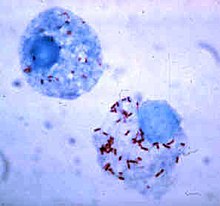Rickettsia rickettsii
| Rickettsia rickettsii | |
|---|---|
 |
|
| Scientific classification | |
| Domain: | Bacteria |
| Phylum: | Proteobacteria |
| Class: | Alphaproteobacteria |
| Order: | Rickettsiales |
| Family: | Rickettsiaceae |
| Genus: | Rickettsia |
| Species: | R. rickettsii |
| Binomial name | |
|
Rickettsia rickettsii Brumpt, 1922 |
|
Rickettsia rickettsii (abbreviated as R. rickettsii) is a gram-negative, intracellular, coccobacillus bacterium that is around 0.8 to 2.0 micrometers long. R. rickettsi is the causative agent of Rocky Mountain spotted fever.R. rickettsii is one of the most pathogenic Rickettsia strains known to humans and affects a large majority of the Western Hemisphere and small portions of the Eastern Hemisphere.
Rocky Mountain spotted fever first emerged in the Idaho Valley in 1896. At that time, not much information was known about the disease; it was originally called Black Measles because patients had a characteristic spotted rash appearance throughout their body. The first clinical description of Rocky Mountain Spotted Fever was reported in 1899 by Edward E. Maxey.
Howard Ricketts (1871–1910);an associate professor of pathology at the University of Chicago in 1902, was the first to identify and study R. rickettsii. At this time, the trademark rash now began to slowly emerge in the western Montana area, with an 80-90% mortality rate. His research entailed interviewing victims of the disease and collecting and studying infected animals. He was also known to inject himself with pathogens to measure their effects. Unfortunately, his research was cut short after his likely death from an insect bite.
S. Burt Wolbach is credited for the first detailed description of the pathogenic agent that causes R. rickettsii in 1919. He clearly recognized it as an intracellular bacterium which was seen most frequently in endothelial cells.
The most common hosts for the R. rickettsii bacteria are ticks. Ticks that carry R. rickettsia fall into the family of Ixodidae ticks, also known as "hard bodied" ticks. Ticks are vectors, reservoirs and amplifiers of this disease.
There are currently three known tick specifics that commonly carry R. rickettsii.
Ticks can contract R. rickettsii by many means. First, an uninfected tick can become infected when feeding on the blood of an infected vertebrate host; such as a rabbit, during the larval or nymph stages, this mode of transmission called transstadial transmission. Once a tick becomes infected with this pathogen, they are infected for life. Both the American dog tick and the Rocky Mountain wood tick serve as long-term reservoirs for Rickettsia rickettsii, in which the organism resides in the tick posterior diverticulae of the midgut, the small intestine and the ovaries. In addition, an infected male tick can transmit the organism to an uninfected female during mating. Once infected, the female tick can transmit the infection to her offspring, in a process known as transovarial transmission.
...
Wikipedia
